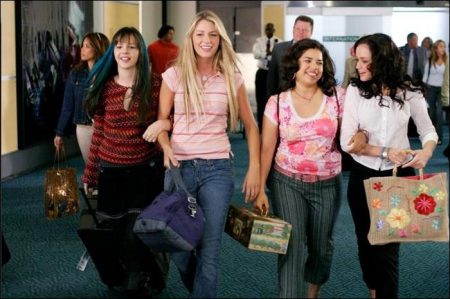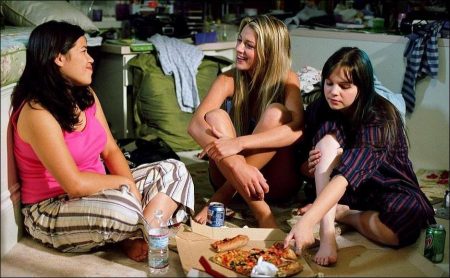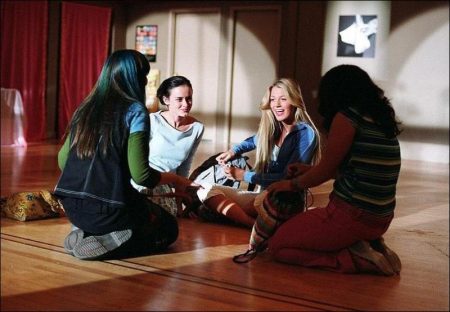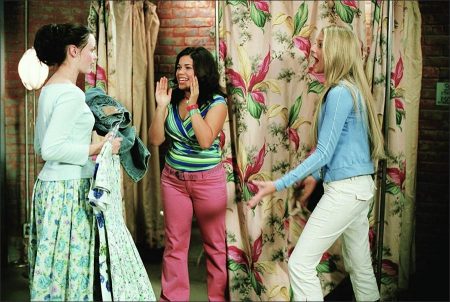Tagline: Laugh. Cry. Share the pants.
The Sisterhood of the Traveling Pants brings to the screen Ann Brashares’ best-selling novel about one very special summer in the lives of four lifelong friends. Introduced as babies who were born to mothers who met in a prenatal aerobics class, the four grew up together and developed an enduring bond despite their distinctly different emerging personalities. Now, after years of sharing every triumph and loss, every wild idea and secret fear with the laughter and love of true friends, these four young women couldn’t be closer… except that they’re about to be separated as their lives take them in different directions for the first time.
Introspective and occasionally volatile Carmen (America Ferrera) is looking forward to spending quality time with her out-of-state dad, whom she hasn’t seen much since he divorced her mother years ago; super-confident star athlete Bridget (Blake Lively) is heading for a soccer camp in Mexico; soft-spoken Lena (Alexis Bledel), a gifted artist as beautiful as her drawings, is set to discover her heritage – and an unexpected romance – on a trip to her grandparents’ home in Greece; and sharp-witted rebel Tibby (Amber Tambly) will reluctantly remain in town, stocking shelves at the local discount store while working on her pet project, a video “suckumentary” to expose what she sees as the banality of everyday life.
On a shopping trip together the day before their paths diverge, the friends find a pair of thrift-shop jeans that amazingly fits and flatters each one of them perfectly, even though they are four young women of very different shapes and sizes. It seems these pants are meant for sharing and that gives Carmen, Bridget, Lena and Tibby a wonderful idea. They decide to use the pants as a way of keeping in touch during the months ahead, each one wearing them for a week to see what luck they bring before mailing them on to the next. In this unique way, though miles apart, the four still experience the challenges and surprises of life as they always have – together – in a summer they’ll never forget.
Production Information
A New York Times best-seller for more than a year after its 2001 publication, The Sisterhood of the Traveling Pants became a national phenomenon, earning high praise from critics as well as readers. The book was consistently voted first choice in mother/daughter book clubs across the country and has prompted comparisons of author Ann Brashares to renowned storyteller Judy Blume in her ability to shine a light on the rich but rough terrain of youth while honestly connecting with readers of all ages.
An avid reader and editor at a small publishing company before taking the plunge into writing, Brashares recalls the inspiration for The Sisterhood of the Traveling Pants, her debut novel. “I was chatting with someone who happened to mention she once shared a pair of pants with some friends, and for some reason that set off a lot of different ideas for me. I imagined who might share this pair of pants, what it means to them and where their lives might take them.”
“The Sisterhood of the Traveling Pants is a full emotional meal,” says producer Debra Martin Chase, who stayed up all night reading the book. “It’s about the power and beauty of friendship and it runs the gamut from intense joy to raw emotion. You find yourself completely identifying with and getting caught up in the journey of these characters.”
Chase, a two-time Emmy Award nominee (Hank Aaron: Chasing the Dream, Rodgers and Hammerstein’s Cinderella) has a resumé distinguished by tales of what she calls “wishfulfillment and empowerment,” such as The Preacher’s Wife, The Princess Diaries and its sequel, The Princess Diaries 2: Royal Engagement. “I like to make films that explore the idea that we all have the power within ourselves to do anything. The only limitations in life are those we put on ourselves. This story is a perfect example of that.”
Producer Denise Di Novi, whose considerable filmmaking credits include successful screen adaptations of the bestselling books Practical Magic and Message in a Bottle, had a similar reaction. Initially assuming it was “a youth novel,” she soon realized that the themes in Brashares’ story transcend age to tap into familiar experiences of “growing into adulthood, realizing your parents aren’t perfect, struggling with self-confidence and facing the unexpected challenges of life with humor and determination – with the all-important support of friends who often know you better than you know yourself.
“I was impressed by the strength of the characters,” she says. “It’s eminently relatable and original, and brings up ideas and issues we’ve all faced and deals with them in an honest way. It’s easy to see why fans can quote whole passages from this book. It’s the kind of book you keep and re-read to find new meaning or to revisit certain times, whether these things happened to you 20 years ago or they’re happening now.”
Chase and Di Novi soon joined forces to develop The Sisterhood of the Traveling Pants, with producers Broderick Johnson and Andrew A. Kosove, founders and co-presidents of Alcon Entertainment.
“What made Broderick and me so passionate about it was how different it was from the traditional approach,” notes Kosove, who, with partner Johnson, has brought a diverse slate of films to the screen, among them Insomnia, Dude Where’s My Car, My Dog Skip and this year’s Racing Stripes. “It’s a smart movie that doesn’t talk down to its audience. Even though our protagonists are young women, the quality and the drama is mature.”
Johnson concurs, adding, “The charm of the story is its authenticity. First love, first loss, the first time we’re confronted with tragedy, and through it all the humor and great times we share with friends – these moments are universal.”
The filmmakers hired writers Delia Ephron (Michael, You’ve Got Mail, the upcoming Bewitched) and Elizabeth Chandler (A Little Princess, What A Girl Wants) to work on a screenplay and the search began for a director.
Chase recalls how director Ken Kwapis met the team’s high expectations in their initial meeting. “In great detail,” she says, “he spoke about each character with complete understanding. Nothing sappy or cute. As he walked out the door I knew, ‘this is the guy.’ This is the guy who can make you smile and have fun and then deliver completely on the emotion and gravity and connect all the dots.”
Renowned in the industry for directing some of the most groundbreaking and intelligent shows on television, beginning with The Larry Sanders Show and including ER, Malcolm in the Middle, Freaks and Geeks, The Bernie Mac Show and The Office, Kwapis shared a 2000 Emmy Award nomination for his producing work on Malcolm in the Middle. He has directed seven features, including He Said, She Said and most recently the independent Sexual Life.
“What struck me most,” Kwapis explains, “was that the four stories were so different and the characters such different types and yet I was able to identify with them equally. It reminded me of a film that had a profound effect on me as a teenager and ultimately steered me toward my career: American Graffiti. I loved all of those characters and felt on some inexplicable level that they represented different aspects of myself. So when I read the Sisterhood script, I knew this should be a film for which every member of the audience sees themselves reflected not in a single character but in several or maybe all of them. There are no villains here, there are only people; people who make good or bad choices and screw up, and these are choices that I’ve made and that everyone in the audience has made.
“Structurally,” he says, “I sometimes thought of it in musical terms, as a piece for four voices. Each of us has known shyness like Lena or dreamt of being impulsive like Bridget. Each of us has a sarcastic, rebellious side, like Tibby and would like to be as passionate and expressive as Carmen. Ultimately, I wanted to create the worlds these young women inhabit so we could eavesdrop on their lives.”
Of paramount importance to the director was “making sure the voices and intention of Ann Brashares’ story were vividly preserved from book to screen.” Brashares, watching the film evolve, reports being “delighted at how it turned out, absolutely true to the spirit of the book,” and notes that Kwapis did not shy away from depicting her characters as she envisioned them, “honestly, warts and all. I wanted them to be natural, with their flaws and weaknesses, their snap judgments and pettiness.”
The Pants: A Symbolic Link for an Unbreakable Friendship
Talking about jeans – the way they fit, the way they look and what they say about the person wearing them – is never a neutral subject. When producer Chase says, “I believe it’s every woman’s fantasy to find the perfect pair of jeans,” she is, admittedly, only half-joking.
“We imbue jeans with a judgmental quality,” says Brashares. “You have your skinny jeans, your fat jeans, your sexy jeans and how they fit is integral to how you feel that day. But this pair transcends all that; it suits these four women equally, differently-built as they are. So we have this traditionally judgmental, restrictive piece of clothing that’s reformed into an object of unconditional acceptance,” which is exactly what these four friends give each other.
“I’ve always liked the idea that clothing can hold emotions and memories or connections to other people, so it wasn’t a stretch to imagine a pair of jeans could be a physical repository for a living friendship,” Brashares continues. “That’s what they came to mean as I wrote the book.”
On the day before they’re due to part, the four young women stop into a thrift store. Impulsively, Carmen grabs a pair of jeans and presses Tibby to try them on. They fit perfectly but Tibby’s not interested and tosses them off to Lena, who protests that she doesn’t wear jeans but tries them on anyway and is surprised to see them fit like a glove. Next up is Bridget, who, although taller than the others, scores another great fit. Finally Carmen, claiming not the slightest expectation of coaxing the zipper up, slips effortlessly into the jeans and at this point the four are convinced that these pants were meant for them to share while they are apart.
Feeling the sadness of their impending separation and anxious about whatever lies ahead for each of them without the support they’ve come to depend upon their entire lives, the young women then sneak into their secret haven, the empty exercise studio where their pregnant mothers met years ago, and improvise a mock ceremony for these incredible pants. Amidst laughter, they create a list of rules – some silly, some serious and all uniquely personal – to govern their use:
1. You must never wash the pants
2. You must never double-cuff them (it’s tacky).
3. You must never say or think you look fat while wearing the pants.
4. You must never let a boy take off the pants (although you may take them off yourself in his presence).
5. You must never pick your nose while wearing the pants.
6. Upon your reunion, you must follow the proper procedures for documenting your time in the pants.
7. You must write to your sisters throughout the summer, no matter how much fun you are having without them.
8. You must pass the pants along to your sisters according to the specifications set down by the Sisterhood.
9. You must not wear the pants with a tucked-in shirt and belt (see Rule #2)
10. Remember: pants equals love. Love your pals. Love yourself.
Of the ten, even Brashares has her favorites, in particular #4. “I’m quite fond of that one, although it’s a bit racy,” she admits. “The idea was that these young women should take charge of all aspects of their lives, decide what to do and what not to do and not allow themselves to be manipulated by anyone or anything.”
“I’ve adopted a slightly agnostic point of view regarding the potential power of these pants,” offers Kwapis, underscoring Brashares’ own intentionally ambiguous approach. “I feel this story is like The Wizard of Oz in that the strength and capability of each character is inside of them all the time. The pants are just the agent that brings this out. Truth is, Carmen has the courage inside to confront her father, Lena has the ability to come out of her shell, Bridget comes to realize that pursuing Eric has more to do with emptiness than love and Tibby discovers how much her anger has been keeping her from experiencing life. Their problems are solved by themselves.”
“The jeans are a metaphor,” suggests Chase. “They link the girls and become a symbol of their connection. Friendship is one of the most important bonds a person can make and will help you get through whatever you must face in life.”
Continue Reading and View the Theatrical Trailer
The Sisterhood of the Traveling Pants (2005)
Directed by: Ken Kwapis
Starring: Blake Lively, Amber Tamblyn, Jenna Boyd, Alexis Bledel, America Ferrera, Nancy Travis, Rachel Ticotin, Mike Vogel, Maria Konstadarou, Erica Hubbard
Screenplay by: Delia Ephron
Production Design by: Gae S. Buckley
Cinematography by: John Bailey
Film Editing by: Kathryn Himoff
Costume Design by: Lisa Jensen
Set Decoration by: Carol Lavallee
Art Direction by: Kelvin Humenny, Helen Jarvis
Music by: Cliff Eidelman
MPAA Rating: PG for thematic elements, sensuality and language.
Distributed by: Warner Bros. Pictures
Release Date: May 20, 2005
Views: 57









